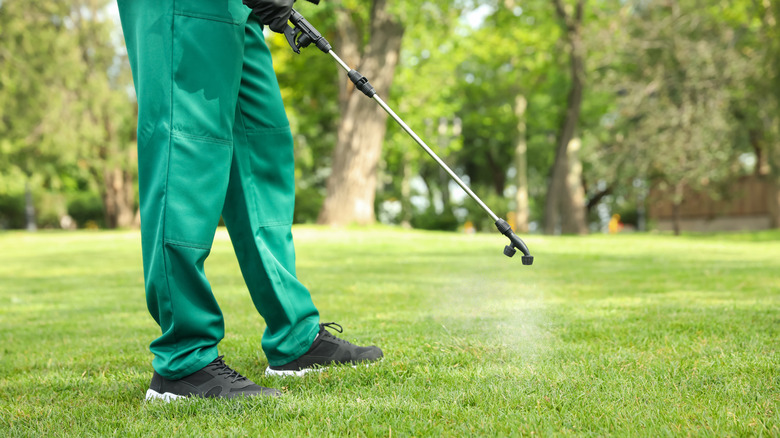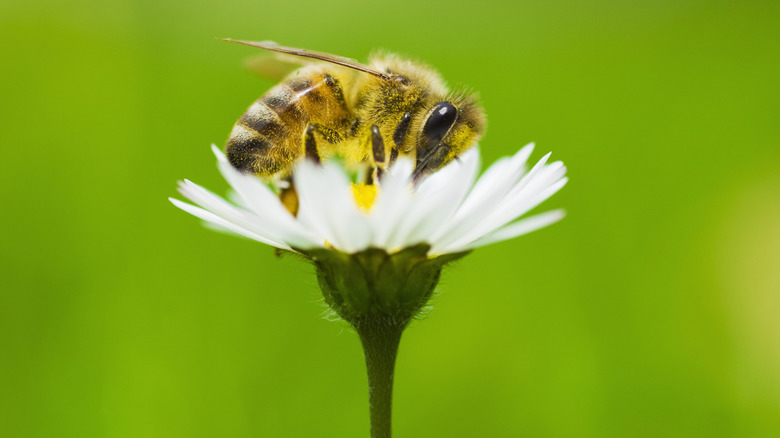Using One Popular Pesticide In Your Garden Is A Dangerous Mistake
Bug-free flowers and pristine lawns are lovely to see. However, under the surface, there's a decent chance you'll find a frightening toxin responsible for their magazine-cover good looks. A group of potent pesticides called neonicotinoids do an amazing job eradicating many types of insect pests from crops and landscaping plants around the world. They are the most commonly used type of pesticide in the US, and they're the active ingredient in scores of insecticides and bug-fighting fertilizer mixes. They even find their way into pets' flea and tick control products.
Neonicotinoids, also known as neonics, are a broader category of indiscriminate systemic pest control chemicals that includes Imidacloprid, Clothianidin, and Dinotefuran, with imidacloprid being the most widely used. They appear in lawn and garden products, agricultural chemicals, and indoor pest treatments. There are over 60 neonicotinoid products on the market just for home and garden use. The list is likely much longer when you consider neonicotinoid products sold for other uses.
These chemicals have been in use since the mid-90s, but recent studies have brought serious concerns to light. There's a convincing, still-growing body of evidence that neonics cause injury to humans, pets, wild birds, and beneficial insects. The EPA has recommended taking precautionary measures while using them and possibly limiting their use, but thus far, there are no official EPA bans on using neonicotinoids. Yet, the European Union has been restricting the use of some neonics for over 10 years due to their potential harm to pollinators. Scientists researching neonics have shared concerns that government agencies aren't taking the threats of these toxins seriously enough.
What are the concerns about neonicotinoids?
The poisons that make neonics so effective against insect pests don't discriminate among bugs. While they're great at killing plant pests, they're also lethal to bees, butterflies, and other pollinating insects. Their effects are long-lasting, as well. After they're applied, a shocking majority of the product both lingers in the soil and washes into waterways. In fact, reports have shown that agriculture in the US is nearly 50% more harmful to all insects since neonic use has become widespread. With bees now dying faster than ever, our food chain runs frightening risks without as many pollinators.
Adverse effects of neonics are reaching bird species in many ways, as well. Loss of habitat, safe water, and insects for food have led to declining bird populations. The toxic effects of the chemicals themselves can damage birds' nervous and reproductive systems. Neonics aren't officially considered dangerous to humans or pets, but some studies have revealed that oral dosing to dogs has caused tremors and trouble walking. Data has also suggested that neonics can affect the nervous system, brain, and reproductive functioning in humans.
Safer alternatives
Homeowners with lawns often face trouble with grubs. Rather than springing for go-to neonicotinoids to take care of these pests, researchers at Michigan State University found that chlorantraniliprole can tackle grubs without harming bee populations. You can also use this chemical to control aphids and some beetles. However, products containing chlorantraniliprole are lethal to butterflies and moths. Another option that appears to be less contentious is pyrethroids. Products containing these compounds are effective against a wide range of insects; they work quickly and are lower in toxicity than many older alternatives. However, there is evidence that they can alter the behavior of bees.
Some experts urge gardeners to choose the least toxic option, even encouraging them to tolerate some pests rather than wanting to wipe them out entirely. If you decide it's not worth the risk to the health of your family and the environment, there are common kitchen ingredients you can use for DIY pest control. While they don't tend to be as effective as conventional pesticides, you may rest easier using them.


